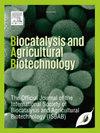Comparative analysis of antifungal properties in medicinal plant extracts for sustainable agriculture
IF 3.4
Q2 BIOTECHNOLOGY & APPLIED MICROBIOLOGY
引用次数: 0
Abstract
The escalating environmental repercussions of pesticide use in pest and disease management underscore the urgency for alternative strategies. One promising avenue involves harnessing natural antifungal properties present in plant extracts. This study aimed to assess the antifungal efficacy of aqueous and ethanolic extracts from five medicinal plants, viz., C. sativa L., S. moorcraftiana L., S. nigrum L., F. vesca L., and R. pseudoacacia, which were screened for their antifungal activity against various soil-borne fungi, viz., A. niger, A. flavus, A. terreus, R. stolonifer, M. mucedo, F. oxysporum, A. alternata, P. notatum, C. cladosporioides, and C. lunata. Phytochemical analysis exhibited the presence of phenols, alkaloids, tannins, flavonoids, quinines, and terpenoids. Results revealed potent antifungal activity across all tested fungi, significantly inhibiting mycelial growth compared to control. S. nigrum and C. sativa extracts exhibited the highest efficacy against multiple fungal pathogens. The inhibition in mycelial growth in ethanolic and aqueous plant extracts of C. sativa against A. niger varies between 3.00 mm to 6.00 mm and 4.00 mm–6.33 mm, against A. flavus 3.33 mm–11.66 mm and 4 mm–12.66 mm, A. terreus (3.00 mm–6.00 mm and 3.66 mm–7.00 mm), R. stolonifer (3.00 mm–5.33 and 3.66 mm–6.33 mm), M. mucedo (8.33 mm–17.66 mm and 9.66 mm–18.66 mm), F. oxysporum (6.66 mm–12.33 mm and 7.33 mm–13.33 mm), A. alternata (4.66 mm–11.33 mm and 5.33 mm–14.00 mm), P. notatum (9.33 mm–23.00 mm and 9.66 mm–24.33 mm), C. cladosporioides (4.33 mm–8.66 mm and 5.33 mm–9.66 mm), and C. lunata (14.00 mm–20.33 mm and 17.00 mm–21.33 mm) in different concentrations of plant extracts respectively. Likewise, the inhibition in mycelial growth in ethanolic and aqueous plant extracts of S. nigrum against A. niger at different concentrations varies between 8.00 mm to 17.66 mm and 9.00 mm–18.66 mm, A. flavus (8.33 mm–12.66 mm and 9 mm–14 mm), A. terreus (2.33 mm–5.66mm and 3 mm–7 mm), R. stolonifer (13.33 mm–20.33 mm and 17.66 mm–24.66 mm), M. mucedo (10.66 mm–12.00 mm and 11.66 mm–13.00 mm), F. oxysporum (15.66 mm–22.33 and 18.00 mm–24.00 mm), A. alternata (10.66 mm–13.00 mm and 11.66 mm–14.00 mm), P. notatum (5.33 mm–13.33 mm and 6.33 mm–18.66 mm, C. cladosporioides (3.33 mm–7.66 mm and 4.00 mm–8.00 mm), and C. lunata (3.66 mm–6.33 mm and 4.66 mm–6.66 mm), respectively. These findings suggest that these plant extracts have the potential to be natural fungicides, providing promising alternatives for disease management in agriculture.
药用植物提取物抗真菌特性的比较分析,促进可持续农业发展
在病虫害防治中使用杀虫剂对环境造成的影响日益严重,这凸显了采取替代战略的紧迫性。利用植物提取物中的天然抗真菌特性是一条很有前景的途径。本研究旨在评估五种药用植物,即 C. sativa L.、S. moorcraftiana L.、S. nigrum L.、F. vesca L. 和 R. pseudoacacia L. 的水提取物和乙醇提取物的抗真菌功效、niger, A. flavus, A. terreus, R. stolonifer, M. mucedo, F. oxysporum, A. alternata, P. notatum, C. cladosporioides, and C. lunata。植物化学分析显示了酚类、生物碱、鞣质、黄酮类、奎宁类和萜类化合物的存在。结果表明,与对照组相比,所有受测真菌都具有很强的抗真菌活性,能明显抑制菌丝生长。黑木耳和藜芦提取物对多种真菌病原体的抗真菌功效最高。荠属植物乙醇提取物和水提取物对黑曲霉的菌丝生长抑制率分别为 3.00 毫米至 6.00 毫米和 4.00 毫米至 6.33 毫米,对黄曲霉的抑制率分别为 3.33 毫米至 11.66 毫米和 4.00 毫米至 6.33 毫米。33毫米-11.66 毫米和 4 毫米-12.66 毫米,A. terreus(3.00 毫米-6.00 毫米和 3.66 毫米-7.00 毫米),R. stolonifer(3.00 毫米-5.33 毫米和 3.66 毫米-6.33 毫米),M. mucedo(8.33 毫米-17.66 毫米和 9.66 mm-18.66 mm)、F. oxysporum(6.66 mm-12.33 mm 和 7.33 mm-13.33 mm)、A. alternata(4.66 mm-11.33 mm 和 5.33 mm-14.00 mm)、P. notatum(9.33 mm-23.00 mm 和 9.66 mm-24.33 mm)、C. cladosporioides(4.33 mm-8.66 mm 和 5.33 mm-9.66 mm)和 C. lunata(14.00 mm-20.33 mm 和 17.00 mm-21.33 mm)。同样,在不同浓度下,黑木耳乙醇提取物和水提取物对黑木耳菌丝生长的抑制作用分别为 8.00 毫米至 17.66 毫米和 9.00 毫米至 18.66 毫米、黄曲霉(8.33 毫米至 12.66 毫米和 9 毫米至 14 毫米)、赤霉病菌(2.33 毫米至 5.66 毫米和 3 毫米至 7 毫米)、匍匐茎菌(13.33 毫米至 20.33 毫米和 17.66 毫米至 24.66 毫米)、M.粘菌(10.66 毫米-12.00 毫米和 11.66 毫米-13.00 毫米)、F. oxysporum(15.66 毫米-22.33 毫米和 18.00 毫米-24.00 毫米)、A. alternata(10.66 毫米-13.00 毫米和 11.66 毫米-14.00 毫米)、P.分别为 5.33 毫米-13.33 毫米和 6.33 毫米-18.66 毫米、C. cladosporioides(3.33 毫米-7.66 毫米和 4.00 毫米-8.00 毫米)和 C. lunata(3.66 毫米-6.33 毫米和 4.66 毫米-6.66 毫米)。这些研究结果表明,这些植物提取物具有天然杀菌剂的潜力,可为农业病害防治提供有前景的替代品。
本文章由计算机程序翻译,如有差异,请以英文原文为准。
求助全文
约1分钟内获得全文
求助全文
来源期刊

Biocatalysis and agricultural biotechnology
Agricultural and Biological Sciences-Agronomy and Crop Science
CiteScore
7.70
自引率
2.50%
发文量
308
审稿时长
48 days
期刊介绍:
Biocatalysis and Agricultural Biotechnology is the official journal of the International Society of Biocatalysis and Agricultural Biotechnology (ISBAB). The journal publishes high quality articles especially in the science and technology of biocatalysis, bioprocesses, agricultural biotechnology, biomedical biotechnology, and, if appropriate, from other related areas of biotechnology. The journal will publish peer-reviewed basic and applied research papers, authoritative reviews, and feature articles. The scope of the journal encompasses the research, industrial, and commercial aspects of biotechnology, including the areas of: biocatalysis; bioprocesses; food and agriculture; genetic engineering; molecular biology; healthcare and pharmaceuticals; biofuels; genomics; nanotechnology; environment and biodiversity; and bioremediation.
 求助内容:
求助内容: 应助结果提醒方式:
应助结果提醒方式:


